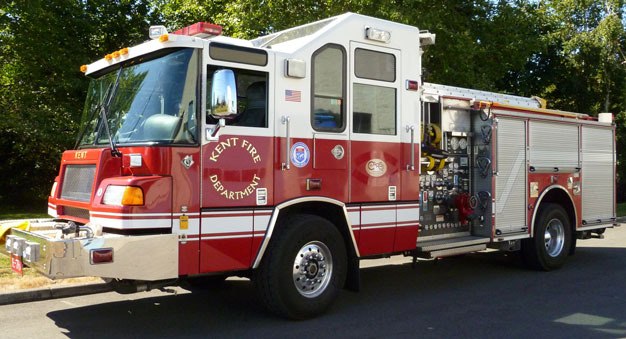The Kent Fire Department Regional Fire Authority has taken several steps over the last two years to be more environmentally friendly and at the same time, reduce costs for residents and businesses.
Utilizing three grants from the state Department of Ecology Clean Diesel Grant Program, Kent has made changes to reduce the amount of diesel exhaust fire engines emit into the atmosphere, according to a Kent Fire Department media release.
The first grant has been used to install crankcase ventilation filter systems in the apparatus. The system works by redirecting engine gasses that would normally be expelled into the atmosphere through a filter that removes oil contaminants. The remaining gasses are then sent back through the combustion system and incinerated.
Funding for the installation of catalytic converters also known as Diesel Oxidation Catalysts in diesel engine fire apparatus was provided by the second state grant. A catalytic converter works by changing much of the carbon monoxide and hydrocarbons that diesel engine exhaust contains into carbon dioxide and water. The catalytic converters can reduce emissions by as much as 80 percent.
Both the catalytic converters and the crankcase ventilation systems were installed in 2011 and 2012.
The third grant to the Kent Fire Department is being utilized to install idle reduction systems in the apparatus. An idle reduction system shuts off the diesel engines of vehicles after they have been parked with the engine running for more than three minutes.
Two types of systems are being installed. One type, for the department’s aid cars, uses auxiliary batteries to keep emergency lights running at scenes after the idle reduction system has shut off the engine. The system automatically will restart the apparatus engine to recharge the batteries if it senses a predetermined drop in voltage.
The second system is designed for the larger vehicles such as fire engines and ladder trucks. It utilizes a small diesel generator mounted on the apparatus to power the emergency lights and other essential systems once the engine shuts down.
A fire engine running at idle for an hour burns approximately three to four gallons of diesel fuel. A fire engine outfitted with an idle reduction system will burn one-third of a gallon of fuel during the same time period.
Additional vehicles will also have the idle reduction system installed as grant funding becomes available.
The benefits of the three systems include:
• Overall reduction in the most toxic airborne pollution caused by diesel engines
• Improved air quality and noise levels for firefighters and the public
• Reduced fuel consumption
• Lower overall fuel costs and use of a natural resource
• Reduced wear and tear on apparatus, extending their in-service life
Talk to us
Please share your story tips by emailing editor@kentreporter.com.
To share your opinion for publication, submit a letter through our website https://www.kentreporter.com/submit-letter/. Include your name, address and daytime phone number. (We’ll only publish your name and hometown.) Please keep letters to 300 words or less.

